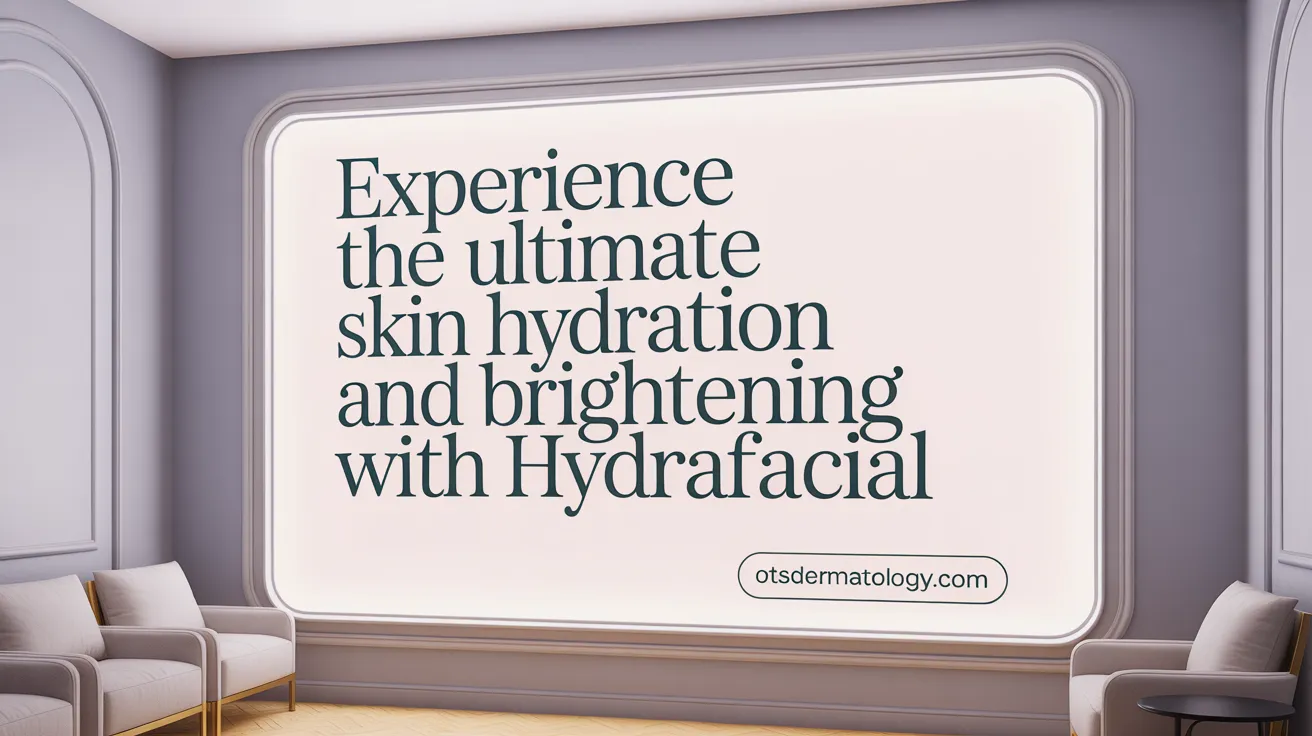Understanding Your Skin’s Needs
In the pursuit of radiant, youthful skin, the skincare market offers a captivating trio of professional treatments: Hydrafacial, Microneedling, and Chemical Peels. Each method boasts unique mechanisms, benefits, and suitability for various skin concerns. Navigating these options with informed clarity can transform your skincare regimen, tailoring treatments to your specific skin goals, type, and sensitivities. This article unpacks these popular treatments, revealing what your skin truly needs for lasting health and glow.
Hydrafacial: A Gentle Powerhouse for Immediate Radiance

What is a Hydrafacial and how does it work?
Hydrafacial is a non-invasive, multi-step skin treatment that uses patented vortex-fusion technology to cleanse, exfoliate, extract impurities, hydrate, and infuse serums rich in antioxidants and peptides. It removes dead skin cells and cleans clogged pores gently while delivering deep moisturization and nourishing ingredients customized to individual skin types and concerns. Learn more about the HydraFacial overview.
Who is Hydrafacial best suited for?
This treatment is suitable for all skin types, including sensitive skin and conditions like rosacea or acne. It is an excellent choice for those who want immediate visible improvements with minimal to no downtime. See more about HydraFacial benefits.
Key benefits and results of Hydrafacial treatments
Hydrafacial smooths, brightens, and deeply hydrates the skin right after treatment. It reduces the appearance of fine lines, wrinkles, pigmentation irregularities, clogged pores, and acne. The procedure enhances skin texture, tone, elasticity, and radiance. Results can last from one to four weeks, with improved longevity from regular sessions. Detailed information about HydraFacial benefits and treatment longevity is available.
Customization options and treatment varieties
Several options are available, including Signature, Radiance, Clarifying, Restorative, and Rejuvenation Hydrafacials, each targeting particular concerns such as sunspots, elasticity loss, or acne. Targeted booster serums and add-ons like LED light therapy and lymphatic drainage can further optimize outcomes. Learn about customizable HydraFacial treatments and HydraFacial booster serums and technologies.
Post-treatment expectations and maintenance
Side effects are typically mild and temporary, such as mild redness, tightness, or tingling lasting up to 72 hours. Patients can resume normal activities immediately. Regular treatments every 4 to 6 weeks, alongside good skincare and sun protection, help maintain and enhance benefits. Guidance on post-treatment care and skin health maintenance is recommended.
Cost considerations and accessibility
Hydrafacial sessions typically take 30 to 60 minutes and range in cost from $150 to $350 per treatment. This cost-effective approach makes it an attractive option for those seeking an effective, gentle facial procedure with immediate results. See information about the cost of HydraFacial treatments.
Microneedling: Stimulating Collagen for Lasting Skin Renewal

How does microneedling work and what is involved in the procedure?
Microneedling is a minimally invasive skin treatment using a handheld device with tiny sterilized needles that create controlled micro-injuries in the skin. These tiny punctures trigger the body's natural healing process, boosting collagen and elastin production. This renewed collagen improves the skin’s elasticity, tone, and texture, helping to restore a youthful glow. For more details, see Microneedling Overview and Microneedling procedure.
What skin concerns can microneedling effectively treat?
This treatment targets a variety of skin issues, including:
- Acne and surgical scars
- Enlarged pores
- Fine lines and wrinkles
- Skin discoloration and hyperpigmentation
- Stretch marks
- Burns and uneven skin texture
Additionally, microneedling can promote hair growth and improve overall skin firmness. See more at Microneedling in Dermatology and Microneedling for Acne Scars.
What are the expected benefits and how soon do results appear?
Patients often see smoother skin and diminished scars or wrinkles within a few weeks after treatment. Full results typically develop over three to six months following multiple sessions spaced several weeks apart. These sessions gradually tighten the skin, reduce blemishes, and even out skin tone. For benefits and timeline, check Microneedling benefits and Microneedling results.
Is microneedling safe, and what side effects might occur?
When performed by trained professionals, microneedling is safe with minimal risks. Common temporary side effects include redness, mild swelling, small bleeding spots, and skin flaking which usually resolve within a few days. Serious complications like infection, scarring, or pigment changes are rare but can occur if treatment is improperly done. For safety info, see Microneedling safety and risks and Microneedling side effects.
What preparation and aftercare are recommended?
Before treatment, patients should avoid blood-thinning medications such as NSAIDs, retinoid use, waxing, and chemical peels for several weeks. Sun exposure should be minimized. After the procedure, it is important to protect skin from sun, avoid makeup and harsh skincare products, keep the skin well hydrated, and refrain from intense physical activity to aid healing. Further guidance can be found at Microneedling pre-and post-care guidelines and What to Expect After Microneedling.
How do professional microneedling treatments compare to at-home devices?
Professional treatments use devices that penetrate deeper into the skin, usually 2-3 mm, enabling effective collagen remodeling. In contrast, at-home dermarollers have shorter needles (~0.25 mm) affecting only the skin surface, offering limited benefits and higher risk if used incorrectly. Professional care ensures safety, proper technique, and optimal lasting results. More info at Microneedling vs at-home rollers and Microneedling benefits and risks.
Chemical Peels: Targeted Exfoliation for Skin Transformation
What types of chemical peels are available and how do they differ?
Chemical peels come in three main types based on the treatment depth: superficial (light), medium, and deep peels.
- Superficial peels use mild acids, such as glycolic acid, to gently exfoliate the outer skin layer. They target fine wrinkles and minor pigmentation issues with minimal downtime. Learn more about Light chemical peels.
- Medium peels reach into the upper dermis and address concerns like acne scars, moderate wrinkles, and uneven skin tone. Details on Medium chemical peels.
- Deep peels penetrate to the lower dermis, treating severe wrinkles, scars, and precancerous growths but involve longer recovery periods and require expert supervision. See the Deep chemical peels overview for more information.
Which skin concerns do chemical peels effectively treat?
Chemical peels are effective for wrinkles, fine lines, sun and age spots, hyperpigmentation, acne scars, uneven texture, and certain precancerous skin conditions. More about Conditions treated with chemical peels.
What are key preparation and recovery aspects for chemical peels?
Preparation includes medical history review, avoiding retinoids, possible antiviral medication, and minimizing sun exposure pre- and post-treatment. Recovery depends on peel depth:
- Superficial peels involve mild redness and brief peeling.
- Medium peels require longer healing with swelling and skin crusting.
- Deep peels have significant downtime with careful post-care needed, including sun protection.
See Preparation and post-treatment care for chemical peels and Chemical peel recovery and risks.
What benefits and risks are associated with chemical peels?
Benefits include enhanced skin texture and tone, collagen stimulation for firmness, reduced pigmentation, and smoother appearance. Risks can involve redness, peeling, temporary or permanent pigmentation changes, scarring, and infection. Deep peels may pose rare systemic risks, so they must be performed by experienced medical professionals. Learn more about Benefits of chemical peels and Risks of chemical peels.
How do chemical peels compare with Hydrafacial and microneedling?
Chemical peels penetrate more deeply than HydraFacial, making them better for pronounced skin issues but with more downtime. Microneedling works by stimulating collagen via micro-injuries beneath the skin, while peels remove damaged surface layers. Combining chemical peels with microneedling or Hydrafacials can optimize skin rejuvenation. See Comparing Microneedling and HydraFacial and HydraFacial vs. Chemical Peels.
Are professional chemical peels preferable to at-home kits?
Professional chemical peels use higher-strength acids tailored to your skin, ensuring safety and better results under licensed practitioners' care. At-home kits have lower acid concentrations and carry risks of misuse and skin damage without guidance. More details on Professional vs. home chemical peels and Benefits of professional chemical peels.
Choosing the Right Treatment: Tailoring to Your Skin Concerns and Goals

How to select the best treatment for specific skin issues?
Microneedling is best suited for deeper skin problems like acne scars, wrinkles, and uneven texture due to its collagen-stimulating effects. HydraFacial is ideal for those wanting immediate skin glow, hydration, and addressing mild aging or acne symptoms with a gentle and noninvasive approach. Chemical peels effectively treat pigmentation, sun damage, and surface irregularities, offering customizable depths to match the severity of the concern.
Are these treatments suitable for all skin types and sensitivities?
HydraFacials are gentle and suitable for all skin types, including sensitive and rosacea-prone skin. Microneedling is generally safe for most skin tones but is not recommended for active acne or some specific skin conditions. Chemical peels' suitability depends on their depth; superficial peels are safe for most skin types, whereas medium and deep peels require caution, especially for darker or sensitive skin, due to increased risk of pigmentation changes (Chemical peels overview).
Can treatments be combined for enhanced results?
Combining treatments, such as using a HydraFacial followed by microneedling or chemical peels, can yield both immediate brightness and long-term skin remodeling benefits. Professional guidance ensures the safe ordering and customization of these procedures for optimized results.
Why is professional consultation and guidance important?
A licensed dermatologist or skincare expert evaluates skin type, tone, and concern to recommend the most appropriate treatment (Selecting skin care treatments). Professional oversight minimizes risks, personalizes treatment protocols, and ensures proper preparation, post-procedure care, and maintenance planning.
What is the recommended frequency and maintenance for these treatments?
HydraFacials are commonly scheduled monthly to maintain skin health and glow. Microneedling treatments are usually spaced 3 to 6 weeks apart in series of 3 to 6 sessions, with yearly maintenance suggested. Chemical peel schedules vary depending on peel depth but often require multiple sessions spaced several weeks apart (Chemical peel overview).
How do cost and time commitments compare among the treatments?
HydraFacials offer quick sessions lasting 30 to 60 minutes, costing around $150 to $350, and involve no downtime. Microneedling involves longer sessions approximately 30 minutes or more, costs $200 to $800 per session, and has mild recovery time. Chemical peels vary widely, from brief superficial treatments with minimal cost and downtime to deep peels requiring significant time, higher costs, and extended healing periods (Chemical peels overview).
Safety, Side Effects, and Aftercare: What to Expect and How to Prepare

What common side effects can patients expect from Hydrafacial, microneedling, and chemical peels?
Hydrafacial side effects are generally mild and temporary, including slight redness, tingling, or skin tightness, usually resolving within 72 hours. Microneedling typically causes redness, swelling, mild bleeding, peeling, and sensitivity that can last several days post-treatment. Chemical peels often lead to redness, swelling, peeling, and heightened sun sensitivity, with recovery times depending on the peel's depth.
What are contraindications and risks to be aware of?
Microneedling is not advised for active acne, eczema, rosacea flare-ups, skin infections, or for individuals taking blood thinners or retinoids. Chemical peels are unsuitable for pregnant women, people with a history of keloids, or certain skin diseases such as eczema or psoriasis. Hydrafacials should be avoided when there is an active rash, sunburn, or known sensitivity to treatment ingredients.
What pre-treatment steps optimize safety and outcomes?
To ensure safe and effective treatments, patients should avoid sun exposure, discontinue retinoid medications and blood thinners as advised, and refrain from waxing or other harsh skin procedures in the weeks prior. Undergoing a professional skin assessment and disclosing relevant health history to the provider is essential. For detailed pre-treatment guidelines, see Microneedling pre-and post-care guidelines and Preparation for chemical peels.
What aftercare measures support healing and prolong benefits?
After treatment, using gentle cleansers, moisturizers, and broad-spectrum sunscreens is critical. Patients should steer clear of exfoliating products, makeup, intense exercise, steam rooms, and direct sun exposure for several days. Maintaining good hydration and adopting a healthy lifestyle, including a balanced diet, sun protection, and avoiding smoking or alcohol, further enhances skin recovery. More on post-treatment care can be found at Microneedling aftercare tips and Aftercare for chemical peels.
Why is sun protection vital following these treatments?
All these treatments increase the skin's vulnerability to UV damage. Without sun protection, patients risk impaired healing, post-inflammatory pigmentation, and accelerated skin aging. Consistent use of broad-spectrum sunscreen, protective clothing, and sun avoidance are indispensable elements of post-procedure care. For further insights, see Sun protection for skin aging prevention.
When should patients seek professional advice post-treatment?
If side effects such as redness, swelling, or irritation worsen or persist beyond typical durations, or if signs of infection, excessive bleeding, scarring, or pain develop, patients should promptly consult their healthcare provider for appropriate evaluation and treatment. Guidance on recognizing complications is available at What to Expect After Microneedling and Chemical peel side effects management.
Making Informed Choices for Healthy, Radiant Skin
Navigating the landscape of professional skin treatments can be overwhelming, yet understanding the distinct benefits, mechanisms, and suitability of Hydrafacial, Microneedling, and Chemical Peels empowers you to make choices tailored to your skin’s unique needs. While Hydrafacial offers gentle, immediate hydration and renewal suitable for all skin types, Microneedling provides deeper collagen stimulation for lasting improvement in texture and scars. Chemical Peels offer targeted exfoliation for pigment and wrinkle correction with variable intensity and recovery. Prioritizing professional consultation and diligent pre- and post-care ensures the safest, most effective outcomes. Ultimately, adopting a personalized, well-informed approach to these transformative treatments can rejuvenate your complexion and promote radiant, healthy skin for years to come.
